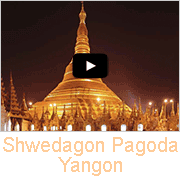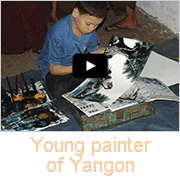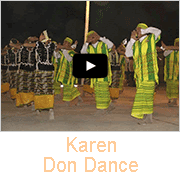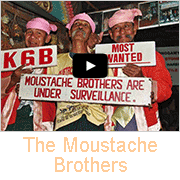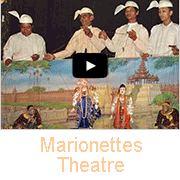Videos of Videos of Myanmar, Myanmar
Videos of Myanmar
The most famous sight of the previous capital of Myanmar, Yangon (formerly Rangoon) is without doubt its Shwedagon Pagoda, towering 98 metres high, with around it smaller zedi (stupas), temples, shrines, images small pavilions, during the day and the night; a wonderful place where whole families come to perform their devotions, stroll or relax among the wonderful architecture and art. Talk about art: a well known sight on one of the the city's main street is Ko Ko Aung, a very talented young boy painting great landscape scenes in a very short time.
The Karen or Kayin people celebrate their New Year at the end of the rice harvest and it is a great occasion with vigorous "Don" dancing in which men and women sing while dancing in two lines, with great energy, the two lines moving, mirroring each other, moving through each other, accompanied by a small group of musicians. Children perform with the same enthusiasm and energy, vigorously maintaining their cultural heritage. Young boys are also eager to have a go in a traditional boxing match, to the sound of a traditional orchestra, under the watchful eye of a referee. At the end of the match they do a victory dance and prostate, paying respect to the monks of the local monastery who have come to watch.
Inle Lake, in the west of Shan State, is the second largest lake in Myanmar and totally unique, with its Intha people, famous for their leg-rowing technique: standing at the stern of their flat-bottomed boats, one leg wrapped around an oar and propelling the boat with their leg. The lake is part of the township of Nyangshwe, located a few kilometres north of the lake. A boat trip goes past old villages and stupas, impressive monasteries like Phaung Daw Oo Paya (the holiest religious site in southern Shan State), the many stupas of Aung Min Ga Lar Paya and the floating gardens of the Intha people. In some villages cottage is industry, where weaving on large looms take place, or paper umbrellas are made, silversmiths make jewellery cheroots are manufactured, cylindrical cigars with both ends clipped.
Mandalay is considered the centre of Myanmar's culture and there are, among others, two very different performances to see. The Moustache Brothers are three brave men, Lu Maw, Lu Zaw and Par Par Lay, who for years have given live performances combining comedy, classic Burmese dance and satirical comments about the repressive military regime. As long as the audience only consisted of foreigners who would leave the country anyway, they have got away with it. The Mandalay Marionettes Theatre opened in 1986 by two female founders, Ma Ma Naing and Naing Yee Mar and since then hour-long performances are given in a small theatre. Five traditional musicians sit on the floor before a small stage. They play drums and the "Hneh", a kind of oboe and the show starts with a musical prelude, followed by marionette performances, depicting different scenes and dances; the puppeteers are sometimes hidden from view by a curtain but on other occasions are fully shown. It is a great performance of Burmese culture, music and folk art.



